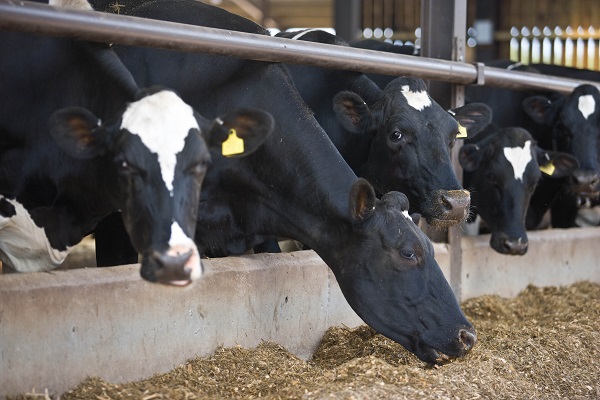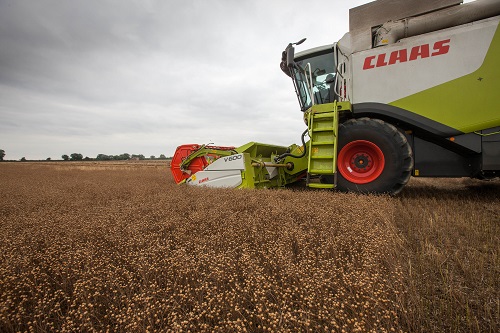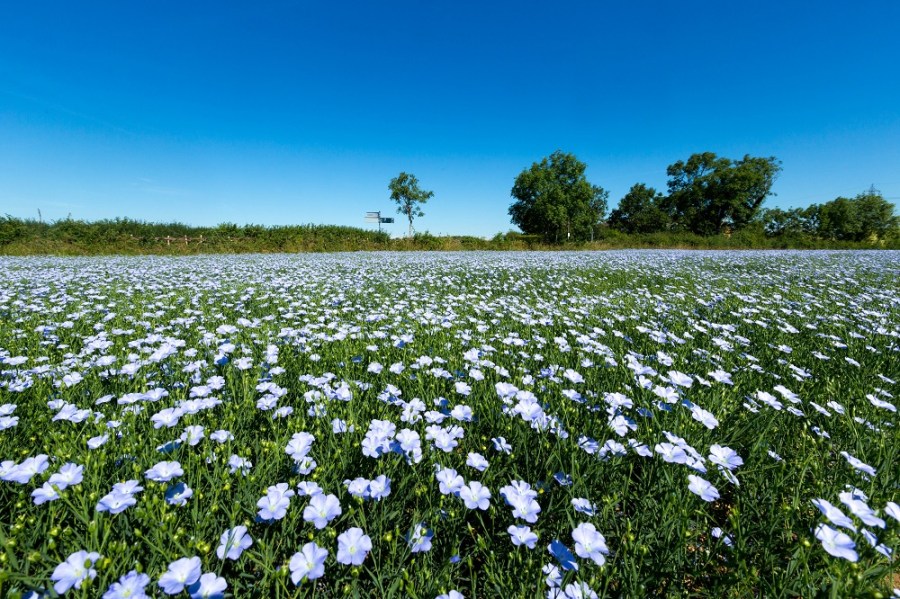The latest spring linseed variety, NuLin, provides growers an opportunity to enter the expanding market for high Omega-3 content while offering a substantial premium over other linseeds and spring crops. CPM reports.
The premium makes it very attractive.
By Melanie Jenkins
Growers looking at spring cropping options may want to turn their attention towards yellow linseed, as one of the newest varieties on the market comes with an attractive premium and early maturity. NuLin – or VT50 as it’s otherwise known – is a new spring linseed from Premium Crops that has plenty to offer growers, and with buyback contracts available, now is the time to consider it.
NuLin was developed specifically for its alpha-linolenic acid (ALA) content – which averages 68-70% compared with 56-58% in conventional varieties. Its target market is through French company Valorex, which processes it for animal feed, according to Andrew Probert, managing director at Premium Crops.

Animals consuming an ALA-rich diet see benefits such as increased fertility, and it can help produce softer butter.
ALA is an essential Omega-3 polyunsaturated fatty acid, in which NuLin is particularly high. Increasing Omega-3 content in animal feed is something that Valorex has been targeting for almost 20 years now, after a dairy farmer approached the firm asking why butter from spring milk was softer than butter from winter milk. The answer, it turned out, was the higher ALA content of grass compared with maize silage.
But it’s not just about producing softer butter. Animal and human nutrition can benefit from higher levels of ALA in their diet, says Stéphane Deleau at Valorex. Animals consuming an ALA-rich diet see benefits such as increased fertility, while humans who consume the meat or milk from these animals can convert the ALA into more useful fatty acids commonly found in fish oil.
Linseed is the plant with the highest level of ALA, above alfalfa and grass, which is why it’s the crop of choice, says Stéphane. “Linseed is also good for the environment as cattle on high Omega-3 diets produce less methane.”
To differentiate products with the higher Omega-3 content, Valorex established the Bleu Blanc Coeur brand in 2000 (which stands for blue-white heart). This labelling system certifies that the product has higher levels of Omega-3, and it’s been highly successful with over €1.6bn (£1.4bn) worth of food products sold under it in France last year. Valorex is anticipating interest in high Omega-3 products to increase, as it’s better for animals, humans and the planet. “It’s not just a question of adding value, but also the philosophical question,” says Stéphane.

For an easier harvest, wait for the afternoon of a hot day and make sure combine knives are sharp and tight, with no up and down play or wriggling.
Growers might wonder why a French company is looking to the UK to produce its linseed and the answer is simple – French farmers don’t grow much spring linseed. Despite efforts to get more linseed grown in France, the uptake has been low so Valorex now relies on the UK to supply 30% of its linseed requirement and 100% of its high ALA need.
Bred in Canada, NuLin brings a different set of genetics to the UK linseed market, as well as the benefit of being tested in harsher conditions. Premium Crops has been trialling the variety for the past three years and has found that it’s able to provide a niche market opportunity, with yields that come in the middle of the pack compared with other varieties (96% of control, according to Premium Crops’ Linseed Descriptive List), and with similar maturity.
Yields should average between 1.8-2.5t/ha, explains Nigel Padbury, seeds and marketing manager at Premium Crops. The only penalty with Nulin is that its yield is 2-3% adrift of other varieties, but growers may consider this is a small drawback when weighed against its valuable premium and early maturity.
Though its first commercial harvest in the UK was only in 2016, by 2018 NuLin could easily account for 25% of all spring linseed grown in the UK, says Nigel.

By 2018 NuLin could easily account for 25% of all spring linseed grown in the UK, says Nigel Padbury.
Contracts are based on the produce of an area, with 50% of the price typically fixed and 50% at a premium over oilseed rape. For the 2018 harvest, the fixed price is £350/t and the premium is £50/t – £25/t more than conventional varieties. “With the extra seed cost of NuLin being about £2/t on the crop output, the premium makes it very attractive.”
Gross margins also stack up in NuLin’s favour, as it offers a noticeably higher gross margin than all other spring cropping options, other than spring milling wheat. “In 2018 farmers can be looking at a gross margin of £550/ha for NuLin, with a price of £350/t, based on 2.5t/ha,” says Nigel.
In terms of market growth, there are other markets that value the ALA content, particularly for direct human consumption – so this’ll likely be the next stage of development, with Valorex already manufacturing human consumption products such as linseed flour and milled seeds, says Nigel. “The demand for Omega-3 products is potentially huge.”
Though some farmers might baulk at the idea of growing linseed – either from previous experiences or out of apprehension – it’s not as challenging as it may appear. Agronomically, NuLin should be treated similarly to other varieties.
Ideally it’s planted from mid-March to mid-April but can be drilled into May, advises Sam Deane, agronomist at Premium Crops. “Growers want to get it in and up before the flax flea beetle arrive.”
Its wide sowing window also gives growers the opportunity to get two flushes of blackgrass in the spring, advises Nigel. Plus, it discourages slugs – so the following wheat crop would likely need less slug pellets.
The variety should be drilled with only around 30% of the total N application in the seed bed (30-40kgN/ha), as it’s great at scavenging N. “NuLin is already a medium height variety and putting N on early would drive it,” says Sam.
“Linseed uses early N just to grow foliage so this won’t help growers with their yield. You want to get a short canopy with lots of flowers and a high yield – so hold back the bulk of the N until it’s at the green bud stage, as this will drive flowers, seed and bolls – apply 60-70kgN/ha at this point and no more than 100kgN/ha in total. Getting high oil and yield is down to getting the N right.”
Linseed likes a fine, firm seedbed – tighter than most crops – and suits min-till, no-till and direct drilling, explains Sam. Growers want to plant at 800 seeds/m² – higher than a normal seed rate – with a normal row width on a cereal drill.
Coordinating weed control should involve pre-emergence applications, as at other stages herbicides can stop the crop growing, he adds. Calisto (mesotrione) and Avadex (triallate) should be used for pre-emergence – but Avadex is only available in granular form for linseed. In cases where post-emergence broadleaf weed control is needed, use Eagle (amidosulfuron), Maya (bromoxynil) or a tank-mix of the two.
It’s worth noting that growth stages are measured in height for linseed until flowering – so this should be referred to for management decisions, explains Sam. Once the crop comes up, keep a look out for flax flea beetle it it’s dry, regardless of temperature. “If the plants are under pressure, the beetle will turn up, so walk it every day until there are two or three sets of true leaves,” he advises. Hallmark Zeon (lambda-cyhalothrin) has approval for use against flax flea beetle in linseed.
As NuLin is a medium height variety – at 61cm – it’s good to slow it down at stem extension with a plant growth regulator. “Use metconazole at 14-15cm if it’s a strong growing season,” adds Sam. “But if it’s dry and the plants are under pressure, the weather should keep it in check.” A good PGR programme at mid stem extension will enhance NuLin’s unique branching ability and this’ll drive yield.
In wet summers it would be beneficial to consider applying tebuconazole to control botrytis, but it’s no more susceptible than any other variety.
NuLin is an early maturing variety, scoring 7, meaning it should be ready between the last week of Aug and the first week of Sept. When desiccating, Sam would steer growers towards diquat rather than glyphosate as linseed doesn’t have enough greenery left for glyphosate to work effectively. “The diquat label says it’ll kill it down in seven days, but it can take 10-14 days, so desiccate in the first half of Aug, looking to harvest in the last week of Aug,” he advises.
Harvesting linseed is one area towards which growers feel some trepidation, but Sam has some handy tips that should mean harvesting is no trouble at all. “It makes a big difference if the sun is shining and it’s a hot day. Make sure combine knives are sharp and tight, with no up and down play or wriggling,” he explains.
“If linseed is ready to go, you just need a sharp knife and there’ll be no problem.” It’s also worth waiting a bit later in the day to combine. “Trying to cut it at 11am wouldn’t be fair on the combine or the driver, so wait and try at 2pm instead.”
It’s still permitted to burn linseed straw on the field but some growers have found markets to sell it to, to fuel boilers, says Sam.
Some farmers see linseed as a last-minute crop for when plans don’t work out. “But NuLin is for the person who has planned it in the rotation, as it’s going for a special end market,” explains Sam. “It needs a little more focus on its height and growth and though it’s a special variety, it doesn’t need special growing practices.”
From a farmer’s point of view, it’s a secure variety to grow, adds Nigel. “It has no major weaknesses and has a premium attached. So if you’re going to grow linseed for 2018, why not grow a variety with a premium?”
Fair results from a late crop
Freddie Wilcox has been growing linseed for five years and, come spring 2018, will be planting his third crop of NuLin. Farming at Quinmoor Farm, Moreton-in-Marsh, Glos, Freddie has 202ha of arable crops, including wheat, barley, oilseed rape, beans and linseed.
In 2016 he grew 16ha of NuLin, which yielded 29t in total, and this year he had just under 10ha, which yielded 20t. “I normally plant it late to get on top of blackgrass and as we had that drought in Apr, it didn’t get planted until mid-May, but it established quite well.” Freddie also upped the seed rate by 10%, to around 900 seeds/m² as it was drilled so late.
This year the NuLin needed no herbicide, fungicide or PGR applications, but the seed bed did have a glyphosate spray before drilling. “There was a bit of flax flea beetle early on but it grew away.”
The crop was late ripening, so Freddie had to keep monitoring it until he could desiccate with diquat. “I managed to harvest it at the end of Sept/ early Oct and it came off the field alright, cutting fairly well. I would have been happier with more yield, but it did go in late.” At around 1.9t/ha, NuLin yielded similarly to other varieties Freddie had previously grown.
“In my experience it’s no different to growing brown linseed and it’s good for tackling blackgrass, making a clean start for the next wheat crop.”




